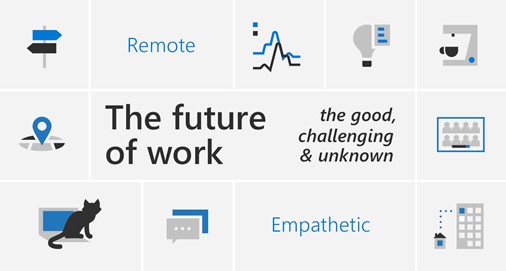
Microsoft’s new Work Trend Index reveals the future of work and life
Microsoft today released its second Work Trend Index report. The research gains insights combined from various sources seek to understand the experience for remote workers today and reimagine the future of work and life.
The research finds that 9 to 5 workday may be fading away as people are working flexible hours from home. The insights derived from Microsoft Teams reveal that people are working more frequently in the morning and evening hours, but also on the weekends. Teams Chats outside of typical working hours have increased between 15% – 23% and spiked to nearly 200% on weekends.
With most of the workforce connecting remotely in the last four months, many are wondering if physical offices will disappear in the future of work. The research indicates that work will likely be a fluid mix of in-person and remote collaboration. For instance, 82% of managers surveyed expect to have more flexible work from home policies post-pandemic. More broadly, 71% of the employees and managers reported a desire to continue working from home at least part-time.
“Our goal for this research is to uncover both good and challenging aspects of remote work so we can accelerate product development in the right areas, anticipate how work will change in the future, and help our customers thrive in this new world of work.” Said Jared Spataro, Corporate Vice President for Microsoft 365. “We see this blending of work and life as a durable workplace trend with potential for technology to help ease some of the challenges that come with it. You’ll see us continuing to innovate in the areas of organizational analytics and employee wellbeing in the near future.”
The Work Trends Index also found that working from home drives more empathy among colleagues. Some 62% of respondents said they feel more empathetic toward their colleagues now that they have a better view of life at home. In some cases, the move to more remote work is also making work more inclusive. Over half (52%) of the people we surveyed feel more valued or included as a remote contributor in meetings because everyone is now in the same virtual room.
The research pointed out the importance of taking regular breaks between meetings, or punctuating long meetings with small breaks when possible. A second study found that brainwave markers associated with overwork and stress are significantly higher in video meetings than non-meeting work such as writing emails. Further, due to high levels of sustained concentration fatigue begins to set in 30-40 minutes into a meeting
To help address these challenges, Microsoft released a series of updates to Teams designed to help create more human connection with co-workers and to reduce meeting fatigue - two of which are Together mode and Dynamic view. ‘Together Mode’ uses AI segmentation technology to digitally place participants in a shared view which reduces background distractions and makes conversations easier. And ‘Dynamic View’ optimizes shared content and video participants using AI to make traditional meetings more engaging.
Microsoft also added additional features to Teams today. These include; focus status that lets your team know you need to set aside time on your calendar for focused work; quiet hours and quiet days to silence notifications in Teams when needed.


























